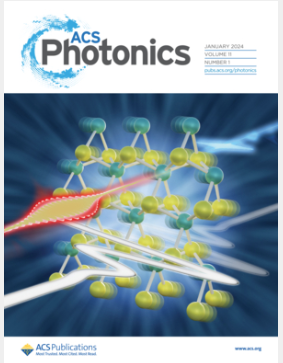Observation of Anisotropic Wavelength-Dependent Acousto-Optic Scattering on X-Cut Thin-Film Lithium Niobate
IF 6.7
1区 物理与天体物理
Q1 MATERIALS SCIENCE, MULTIDISCIPLINARY
引用次数: 0
Abstract
We investigate an integrated acousto-optic (AO) device featuring electrically driven anisotropic surface acoustic waves on X-cut thin-film lithium niobate (TFLN). Notably, we observe a novel phenomenon of wavelength-dependent periodic fluctuations in anisotropic AO scattering with different in-plane orientations. This effect is attributed to inter-polarization scattering involving the fundamental modes combined with intramodal AO interaction within the TFLN waveguide. Therefore, the trade-off between efficiency and fluctuation must be carefully considered. When the acoustic excitation direction is 150° (relative to the −Y-axis of LN), the Rayleigh acoustic mode R0 achieves a maximum intramodal scattering efficiency of −20.9 dB at 2.496 GHz, which corresponds to a VπL of 2.34 V·cm. Additionally, the higher-order acoustic mode at 3.544 GHz demonstrates a moderate conversion efficiency of −26.7 dB under a 75° emission angle, with a minimal wavelength-dependent fluctuation of 1.1 dB during AO modulation operation over a bandwidth exceeding 82 nm. By carefully selecting specific orientations or wavelengths, it is possible to tailor diverse applications for anisotropic TFLN AO devices, such as highly flattened AO modulation, enhanced intramodal AO interaction, and efficient inter-polarization conversion. These findings pave the way for developing integrated photonic–phononic interaction devices on widely utilized anisotropic material platforms.

x -切割铌酸锂薄膜声光散射的各向异性观察
我们研究了一种集成声光(AO)装置,该装置具有电驱动的各向异性表面声波在x切割薄膜铌酸锂(TFLN)上。值得注意的是,我们在不同面内取向的各向异性AO散射中观察到一种新的波长依赖周期波动现象。这种效应归因于TFLN波导中涉及基模的极化间散射和模内AO相互作用。因此,必须仔细考虑效率与波动之间的权衡。当声激励方向为150°(相对于LN的- y轴)时,瑞利声模式R0在2.496 GHz处的最大模内散射效率为- 20.9 dB,对应的Vπ l为2.34 V·cm。此外,在3.544 GHz高阶声模式下,在75°发射角下的转换效率为- 26.7 dB,在超过82 nm的带宽上,AO调制操作期间的波长相关波动最小为1.1 dB。通过仔细选择特定的方向或波长,可以为各向异性TFLN AO器件量身定制各种应用,例如高度扁平的AO调制,增强的模内AO相互作用和高效的偏振间转换。这些发现为在广泛应用的各向异性材料平台上开发集成光子-声子相互作用器件铺平了道路。
本文章由计算机程序翻译,如有差异,请以英文原文为准。
求助全文
约1分钟内获得全文
求助全文
来源期刊

ACS Photonics
NANOSCIENCE & NANOTECHNOLOGY-MATERIALS SCIENCE, MULTIDISCIPLINARY
CiteScore
11.90
自引率
5.70%
发文量
438
审稿时长
2.3 months
期刊介绍:
Published as soon as accepted and summarized in monthly issues, ACS Photonics will publish Research Articles, Letters, Perspectives, and Reviews, to encompass the full scope of published research in this field.
 求助内容:
求助内容: 应助结果提醒方式:
应助结果提醒方式:


